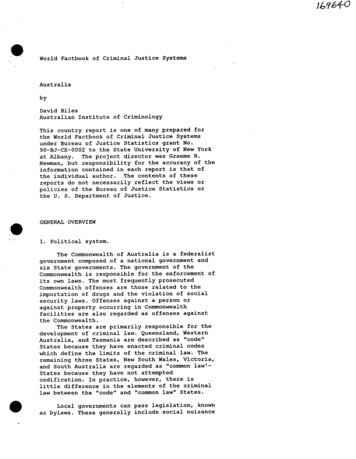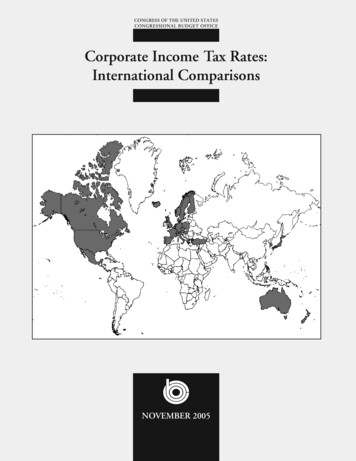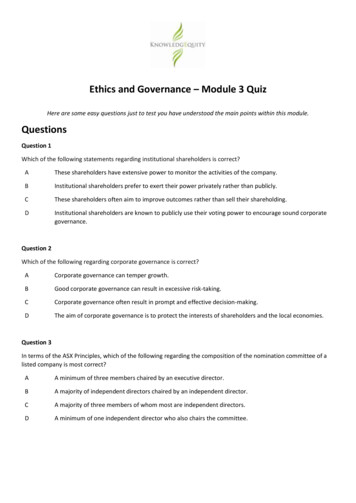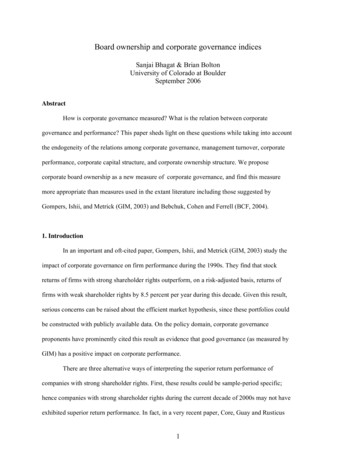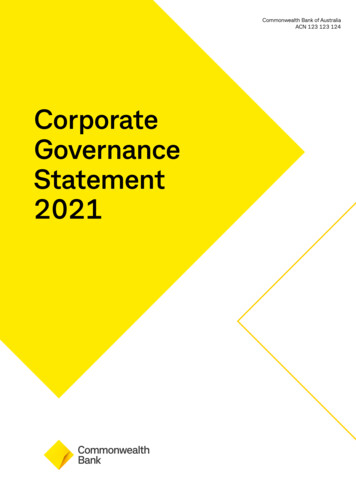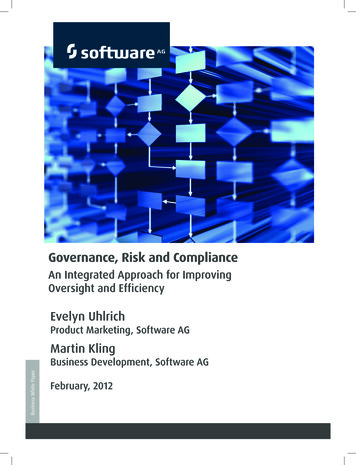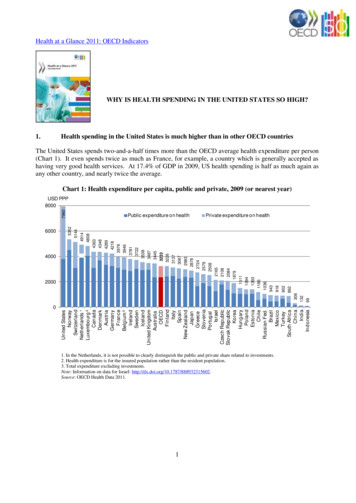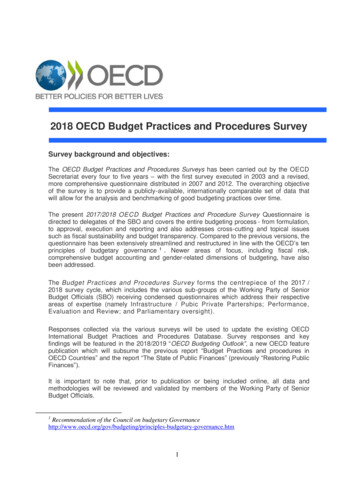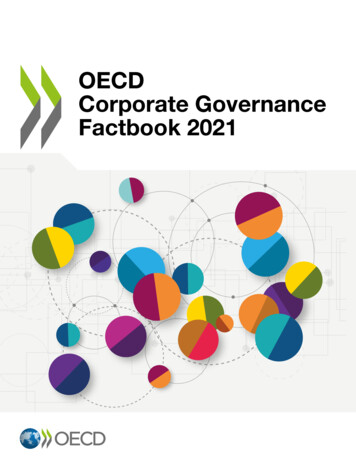
Transcription
OECDCorporate GovernanceFactbook 2021
1OECD Corporate GovernanceFactbook 2021PUBE
Please cite this publication as:OECD (2021), “OECD Corporate Governance Factbook 2021”, -factbook.htm. OECD 2021This work is published under the responsibility of the Secretary-General of the OECD. The opinions expressedand arguments employed herein do not necessarily reflect the official views of OECD member countries.This document, as well as any data and any map included herein, are without prejudice to the status of orsovereignty over any territory, to the delimitation of international frontiers and boundaries and to the name of anyterritory, city or area.The statistical data for Israel are supplied by and under the responsibility of the relevant Israeli authorities. Theuse of such data by the OECD is without prejudice to the status of the Golan Heights, East Jerusalem and Israelisettlements in the West Bank under the terms of international law.
3PrefaceGood corporate governance and well-functioning capital markets are always important, but perhaps evenmore critical now, both to support the recovery from the COVID-19 crisis and to further strengthen resilienceto possible future shocks.This 2021 edition of the OECD Corporate Governance Factbook offers a comprehensive account of howthe G20/OECD Principles of Corporate Governance are implemented around the world. With comparativeinformation across 50 jurisdictions including all OECD, G20 and Financial Stability Board members, theFactbook supports informed policy-making by providing up-to-date information on the ways in whichdifferent countries translate the Principles’ recommendations into their national legal and regulatoryframeworks.Access to systematic and comparable information across all jurisdictions that adhere to the G20/OECDPrinciples of Corporate Governance has never been more important. The OECD’s Corporate GovernanceCommittee has initiated a process of reviewing and updating these Principles. It is crucial that this reviewis based on a clear understanding of existing institutional and legal frameworks, and draws on the recentexperiences and challenges highlighted by the COVID-19 pandemic, such as risk and crisis management(including health, supply chain and environmental risks) as well as issues related to audit quality, increasedownership concentration and complex company group structures. The Factbook provides information onthis changing market context and how regulatory frameworks are adapting to it.In the context of rebuilding our economies in the wake of the COVID-19 crisis and promoting stronger,cleaner and fairer economic growth, good corporate governance plays an essential role. It fosters anenvironment of market confidence and business integrity that supports capital market development. Thequality of a country’s corporate governance framework is decisive for the dynamism and thecompetitiveness of its business sector and the economy at large. It will also support the corporate sectorto manage environmental, social and governance (ESG) risks and better harness the contributions ofdifferent stakeholders, be it shareholders, employees, creditors, customers, suppliers, or adjacentcommunities, to the long-term success of corporations.This latest edition of the Factbook confirms that regulatory frameworks related to corporate governancehave been evolving substantially. For example, since the Principles were last updated in 2015, 90% of thejurisdictions have amended either their company law or securities law, or both. Governments have had toadapt their regulatory frameworks significantly to respond to the circumstances imposed by the COVID-19pandemic by, for example, accommodating virtual shareholder meetings and remote electronic voting.Stricter requirements for both companies and institutional investors to disclose voting results, and forcompanies to improve their disclosure of related party transactions, have reinforced accountability ofshareholders and companies.OECD CORPORATE GOVERNANCE FACTBOOK 2021 OECD 2021
4 In this unique recovery context for the global economy, where capital markets and corporations continueto evolve and new and evolving challenges arise, the Factbook provides an essential tool for helping policymakers and regulators stay abreast of the changing corporate governance landscape, and for sharing howpolicies and practices can be adapted to remain effective under new circumstances. The Factbook willplay a vital role in informing the ongoing review of the G20/OECD Principles of Corporate Governance,taking place at the OECD with the participation of all G20 countries. As the leading international standardin the field of corporate governance they will also continue to inform other instruments, such as those onsustainable finance advanced by the G20 and related fora.I count on us collectively making the most of this important tool and wish to thank the CorporateGovernance Committee and all participating jurisdictions for making this information available in such atimely, succinct and comprehensive fashion.Mathias CormannOECD Secretary-GeneralOECD CORPORATE GOVERNANCE FACTBOOK 2021 OECD 2021
5ForewordThe OECD Corporate Governance Factbook supports the implementation of good corporate governancepractices by providing an easily accessible and up-to-date, factual underpinning to help understand countries’institutional, legal and regulatory frameworks. Governments may use the Factbook to compare their ownframeworks with those of other countries or to obtain information about policies and practices in specificjurisdictions. It also serves as a useful reference for market participants and analysts seeking to understandhow such frameworks vary across different jurisdictions, and how they have been evolving.The core information in the Factbook is taken from OECD thematic reviews on how OECD, G20 and FinancialStability Board member jurisdictions address major corporate governance challenges such as board practices(including remuneration); the role of institutional investors; related party transactions and minority shareholderrights; board member nomination and election; supervision and enforcement; and risk management. Additionalsections address the corporate governance landscape, including ownership patterns, data on stock exchangesand their market activities; and the institutional and regulatory landscape. First published in 2014, the Factbookis updated every two years.In addition to updating provisions enacted across all issue areas through to end-2020, this year’s editionprovides a wealth of new information. A new chapter analyses the global market and corporate ownershiplandscape, taking account of developments related to the COVID-19 crisis. New or expanded sectionscover frameworks for the regulation and supervision of external audit, the regulation of proxy advisors andtrends related to the gender composition of boards and senior management.The Factbook is divided into four main chapters: 1) the global market and corporate ownership landscape;2) the corporate governance and institutional framework; 3) the rights of shareholders and key ownershipfunctions; and 4) the corporate board of directors. Each chapter offers a narrative overview with figures,which helps to provide an overall picture of main tendencies and variations in approaches taken by differentjurisdictions. This is further supported by 63 figures and 42 tables, providing comparative information onall 38 OECD members (now including the most recent new member Costa Rica), and all G20 and FinancialStability Board members including Argentina, Brazil, the People’s Republic of China, Hong Kong (China),India, Indonesia, the Russian Federation, Saudi Arabia, Singapore and South Africa. Two additionaljurisdictions that actively participate in the OECD Corporate Governance Committee -- Malaysia and Peru-- are also covered in this latest edition.The Factbook compiles information gathered from 50 jurisdictions participating in the work of the OECDCorporate Governance Committee. It is the collective achievement of the Committee and the individualefforts of the delegates from all jurisdictions, who diligently reviewed and updated the information to ensureaccuracy. The Factbook was prepared by Daniel Blume, Emeline Denis and Katrina Baker under thesupervision of Serdar Çelik, with additional support from Alejandra Medina and the Corporate Governanceand Finance Division team within the OECD Directorate for Financial and Enterprise Affairs.OECD CORPORATE GOVERNANCE FACTBOOK 2021 OECD 2021
7Table of ContentsPrefaceForewordExecutive summaryThe global market and corporate ownership landscapeThe corporate governance and institutional frameworkThe rights of shareholders and key ownership functionsThe corporate board of directors1. The global market and corporate ownership landscape1.1. Introduction1.2. Global trends in stock markets and listed company landscape1.3. Initial public offerings (IPOs) trends1.4. Increased importance of secondary offerings1.5. Changes in the corporate ownership and investor landscape1.6. The prevalence of concentrated ownership1.7. The growing importance of corporate bond financing2. The corporate governance and institutional framework2.1. The regulatory framework for corporate governance2.2. The main public regulators of corporate governance3. The rights of shareholders and key ownership functions3.1. Notification of general meetings and information provided to shareholders3.2. Shareholders' right to request a meeting and to place items on the agenda3.3. Shareholder voting3.4. Related party transactions3.5. Takeover bid rules3.6. The roles and responsibilities of institutional investors and related intermediaries4. The corporate board of directors4.1. Basic board structure and independence4.2. Board-level committees4.3. Auditor independence, accountability and oversight4.4. Board nomination and election4.5. Board and key executive remuneration4.6. Gender composition on boards and in senior managementReferencesOECD CORPORATE GOVERNANCE FACTBOOK 2021 OECD 84139139146151156160165243
8 TablesTable 1.1 Market and ownership characteristics, 2020Table 1.2 The largest stock exchangesTable 2.1 The main elements of the regulatory framework: Laws and regulationsTable 2.2 The main elements of the regulatory framework: National codes and principlesTable 2.3 The custodians of national codes and principlesTable 2.4 National reports on corporate governanceTable 2.5 The main public regulators of corporate governanceTable 2.6 Budget and funding of the main public regulator of corporate governanceTable 2.7. Size and composition of the governing body/head of the main public regulator of corporategovernanceTable 2.8 Terms of office and appointment of the governing body/head of the main public regulator ofcorporate governanceTable 3.1 Means of notifying shareholders of the annual general meetingTable 3.2 Shareholder rights to request a shareholder meeting and to place items on the agendaTable 3.3 Preferred shares and voting capsTable 3.4 Voting practices and disclosure of voting resultsTable 3.5 Sources of definition of related partiesTable 3.6. Disclosure of related party transactionsTable 3.7. Board approval for related party transactionsTable 3.8 Shareholder approval for related party transactions (non-equity)Table 3.9 Takeover bid rulesTable 3.10 Roles and responsibilities of institutional investors and related intermediaries: Exercise of votingrights and management of conflicts of interestTable 3.11 Main roles and responsibilities of institutional investors and related intermediaries: Stewardship /fiduciary responsibilitiesTable 4.1 Basic board structure: Classification of jurisdictionsTable 4.2 One-tier board structures in selected jurisdictionsTable 4.3 Two-tier board structures in selected jurisdictionsTable 4.4 Examples of a hybrid board structureTable 4.5 Board size and director tenure for listed companiesTable 4.6 Board independence requirements for listed companiesTable 4.7 Requirement or recommendation for board independence depending on ownership structureTable 4.8 Employees on the boardTable 4.9 Board-level committeesTable 4.10 Governance of internal control and risk managementTable 4.11 Appointment of external auditorsTable 4.12 Provisions to promote external auditor independence and accountabilityTable 4.13 Audit oversightTable 4.14 Voting practices for board electionTable 4.15 Board representation of minority shareholdersTable 4.16 Governance of board nominationTable 4.17 CEO and executive turnoverTable 4.18 Requirements or recommendations for board and key executives remunerationTable 4.19 Disclosure and shareholder approval of board and key executive remunerationTable 4.20 Provisions to achieve gender diversity in leadership positionsTable 4.21 Gender composition of boards and 21223225228230232235240FiguresFigure 1.1 Universe of listed companies, as of end 2020Figure 1.2 Initial public offerings (IPOs), total amount raisedFigure 1.3 Top 20 jurisdictions by number of non-financial company IPOs during last 10 yearsFigure 1.4 Newly listed and delisted companiesFigure 1.5 Secondary public offerings (SPOs), total amount raisedFigure 1.6 Investors’ public equity holdings, as of end 2020182020212223OECD CORPORATE GOVERNANCE FACTBOOK 2021 OECD 2021
9Figure 1.7 Ownership landscape at the regional level, as of end 2020 (% share)Figure 1.8 Ownership concentration by market, as of end 2020Figure 1.9 Ownership concentration at the company level, as of end 2020Figure 2.1 Implementation mechanisms for corporate governance codes and regulationsFigure 2.2 Custodians of corporate governance codesFigure 2.3 National reporting on adherence to corporate governance codesFigure 2.4 Who is the regulator of corporate governance?Figure 2.5 How is the regulator funded?Figure 2.6 What size are boards of regulators?Figure 2.7 What term of office do board members/heads of the regulator serve?Figure 3.1 Minimum public notice period for general shareholder meetings and requirements for sendingnotification to all shareholdersFigure 3.2 What is the means of shareholder meeting notification?Figure 3.3 Deadline for holding the meeting after shareholder requestsFigure 3.4 Minimum shareholding requirements to request a shareholder meeting and to place items on theagendaFigure 3.5 Issuance of shares with limited or no voting rightsFigure 3.6 Formal vote counting and disclosure of the voting resultsFigure 3.7 Regulatory frameworks for related party transactionsFigure 3.8 Disclosure of related party transactions in financial statementsFigure 3.9 Board approval for certain types of related party transactionsFigure 3.10 Shareholder approval for certain types of related party transactionsFigure 3.11 Takeover bid rulesFigure 3.12 Lowest threshold for mandatory takeover bidsFigure 3.13 Requirements for minimum bidding price in mandatory takeover bidsFigure 3.14 Disclosure of voting policies and actual voting records by institutional investorsFigure 3.15 Existence and disclosure of conflicts of interest policies by institutional investorsFigure 3.16 Stewardship and fiduciary responsibilities of institutional investorsFigure 3.17 Requirements and recommendations for proxy advisorsFigure 4.1 Maximum term of office for board members before re-electionFigure 4.2 Minimum number or ratio of independent directors on the (supervisory) boardFigure 4.3 Board independence requirement or recommendation and ownership structureFigure 4.4 Separation of CEO and chair of the board in one-tier board systemsFigure 4.5 Requirements for the independence of directors and their independence from substantialshareholdersFigure 4.6 Definition of independent directors: Maximum tenureFigure 4.7 Board-level committees by category and jurisdictionFigure 4.8 Independence of the chair and members of board-level committeesFigure 4.9 Board responsibilities for risk managementFigure 4.10 Implementation of the internal control and risk management systemFigure 4.11 Board-level committee for risk managementFigure 4.12 Responsibility for appointing/approving an external auditorFigure 4.13 Role of the audit committee in relation to the external auditFigure 4.14 Maximum term years before mandatory audit firm rotationFigure 4.15 Provisions on non-audit servicesFigure 4.16 Audit oversightFigure 4.17 Majority voting requirement for board electionFigure 4.18 Cumulative votingFigure 4.19 Qualification requirements for board member candidatesFigure 4.20 Information provided to shareholders regarding candidates for board membershipFigure 4.21 Criteria for board and key executive remunerationFigure 4.22 Specific requirements or recommendations for board and key executive remunerationFigure 4.23 Requirement or recommendation for shareholder approval on remuneration policyFigure 4.24 Requirement or recommendation for shareholder approval on level/amount of remunerationFigure 4.25 Disclosure of the policy and amount of remunerationFigure 4.26 Provisions to disclose data on the gender composition of boards and of senior managementFigure 4.27 Provisions to enhance gender diversity on boards of listed companies and SOEsFigure 4.28 Women's participation on boards and in managementOECD CORPORATE GOVERNANCE FACTBOOK 2021 OECD 155156157157159159160161162163164166167169
10 Figure 4.29 Average share of women on boards (2019) and annual average growth rates of women on boardsof listed companies (2017-2019)170Figure 4.30 Share of women on boards of listed companies as of 2019 according to differing target and quotalevels173BoxesBox 2.1 Variations on comply-or-explain reporting on corporate governance codesBox 4.1 National provisions to facilitate effective minority shareholder participation in board selection34158OECD CORPORATE GOVERNANCE FACTBOOK 2021 OECD 2021
11Executive summaryThe 2021 edition of the OECD Corporate Governance Factbook contains comparative data and informationacross 50 jurisdictions including all G20, OECD and Financial Stability Board members. The informationis presented and commented in 63 figures and 42 tables covering a broad range of institutional, legal andregulatory provisions. The Factbook provides an important and unique tool for monitoring theimplementation of the G20/OECD Principles of Corporate Governance (the “G20/OECD Principles”).Issued every two years, it is actively used by governments, regulators and other stakeholders forinformation about implementation and latest trends. It is divided into four chapters addressing:1) the global market and corporate ownership landscape;2) the corporate governance and institutional framework;3) the rights of shareholders and key ownership functions; and4) the corporate board of directors.This edition provides substantially new material. It contains a new first chapter covering global trends instock markets and the corporate landscape, including data on the impact of the COVID-19 crisis on thefunctioning of capital markets. The remaining three chapters have been substantially updated throughoutto reflect changes in jurisdictions’ institutional, legal and regulatory frameworks since the Factbook waslast issued in 2019. In addition, as part of the third chapter, new coverage on requirements for proxyadvisors has been added. Within the fourth chapter addressing the responsibilities of the board of directors,this edition also includes a new section covering provisions underpinning auditor independence,accountability and oversight, as well as new data to reflect trends in the gender composition of boards andsenior management.The global market and corporate ownership landscapeEffective design and implementation of corporate governance policies requires a good empiricalunderstanding of the ownership and business landscape to which they will be applied. The first chapter ofthe Factbook therefore provides a global overview of developments related to stock markets, includingtheir size, activities and ownership characteristics. It also provides insights into lessons from the COVID-19crisis and its impact on the functioning of capital markets.Overall, stock markets play a key role in providing companies with equity capital that gives them thefinancial resilience to overcome temporary downturns, as evidenced in the aftermath of the 2008 financialcrisis whereby publicly listed non-financial companies raised a record USD 511 billion in new equity. Thispattern re-emerged during the 2020 COVID-19 pandemic when listed non-financial companies raised arecord of USD 626 billion in new equity. While the United States remained the largest market measuredby market capitalisation as of end 2020, Asia as a region comprised the highest number of listedcompanies, with Asian companies having raised 47% of all global IPO proceeds between 2009 and 2020.OECD CORPORATE GOVERNANCE FACTBOOK 2021 OECD 2021
12 The growth of Asian markets is mainly driven by a surge in the number of Chinese IPOs, which has morethan tripled between the 1990s and the post-2008 period. Overall, the shift towards Asia has been evenmore pronounced with respect to IPOs by non-financial companies.However, despite recent growth in overall global market capitalisation, almost 30 000 companies havedelisted from the stock markets globally since 2005, resulting in a net loss of listed companies in the OECDarea every single year between 2008 and 2019. In particular, the substantial and structural decline inlistings of smaller growth companies in some advanced markets has distanced a large portion of thesecompanies from ready access to public equity financing.These trends have raised concerns that stock markets increasingly have become a source of funding forfewer and larger companies. While this can be partly explained by the lower cost of debt financing andbetter access to private capital, other developments have led to structural weaknesses in the capital marketecosystem. These include the shift from retail direct investments to large institutional investors; changesin the business model of stock exchanges since the mid-1990s; high underwriting fees discouragingcompanies from going public; and systematic acquisitions of smaller growth companies – especially bylarge technology companies – contributing to drying up the IPO pipeline of smaller independent companies.The increase in institutional ownership stands as one of the most significant changes in the ownershipstructure of the world’s listed companies. At global aggregate level, institutional investors represent thelargest investor category by holding 43% of the world market capitalisation, followed by privatecorporations holding 11%, the public sector holding 10%, and strategic individuals owning 9%. The relativeimportance of the different investor categories varies across markets. Institutional investors represent thelargest shareholder category in the United States, Europe, Japan and other advanced markets, while theyrepresent the smallest category in China where the public sector accounts for the largest investor category,holding almost 30% of all shares. Asian listed companies also have a significant portion of their sharesheld by other corporations.Another less recognised development is the increase in ownership concentration at the company level –which is important not only for the relationship between owners and managers, but also for the relationshipbetween controlling and non-controlling owners. In 28 of 45 surveyed markets, the three largestshareholders hold on average more than 50% of the company’s equity capital. Conversely, the marketswith the least ownership concentration, measured as the combined holdings of the three largestshareholders, are the United States, Australia, Finland, Canada, Iceland and the United Kingdom, wherethe three largest shareholders still hold a significant average combined share, ranging between 33% and36% of the company’s capital. Overall, while the degree of ownership concentration at the company levelstill differs between markets and companies, no jurisdiction systematically features the kind of atomisticdispersed ownership structure that still influences much of the corporate governance debate.The corporate governance and institutional frameworkThe quality of the legal and regulatory framework stands as an important foundation for implementing theG20/OECD Principles, in line with the rule of law in supporting effective supervision and enforcement.Against this background, Chapter 2 provides information on who serves as the lead regulatory institutionfor corporate governance of listed companies in each jurisdiction, as well as issues related to theirindependence. In all surveyed jurisdictions, public regulators have the authority to supervise and enforcethe corporate governance practices of listed companies – with securities regulators, financial regulators ora combination of the two playing the key role in 82% of surveyed jurisdictions, and the Central Bank playingthe key role in 16%. The issue of the independence of regulators is commonly addressed (among 86% ofregulatory institutions) through the creation of a formal governing body such as a board, council orOECD CORPORATE GOVERNANCE FACTBOOK 2021 OECD 2021
13commission, usually appointed to fixed terms ranging from two to eight years. In a majority of cases,independence from the government is also promoted by establishing a separate budget funded by feesassessed on regulated entities or a mix of fees and fines. On the other hand, 21% of the regulatoryinstitutions surveyed are funded by the national budget.Since 2015 when the G20/OECD Principles were last updated, 90% of the 50 surveyed jurisdictions haveamended either their company law or securities law, or both. Nearly all jurisdictions also have nationalcodes or principles that complement laws, securities regulation and listing requirements. Nearly two-thirdsof jurisdictions have revised their national corporate governance codes over the past four years, and 94%of them follow a “comply or explain” approach or a variation of this. A growing percentage of jurisdictions– 62% – now issue national reports on company implementation of corporate governance codes. Nationalauthorities serve as custodians of the national corporate governance code in 26% of the 47 jurisdictionsthat have such codes, while they exercise this role jointly with stock exchanges in another 9%.The rights of shareholders and key ownership functionsThe G20/OECD Principles state that the corporate governance framework shall protect and facilitate theexercise of shareholders’ rights and ensure equitable treatment of all shareholders. Chapter 3 thereforeprovides detailed information related to rights to obtain information on shareholder meetings, to requestmeetings and to place items on the agenda, and voting rights. The chapter also covers frameworks forreview of related party transactions, triggers and mechanisms related to corporate takeover bids, and theroles and responsibilities of institutional investors and related intermediaries.All jurisdictions require companies to provide advance notice of general shareholder meetings. A majorityestablish a minimum notice period of between 15 and 21 days, while another 36% of jurisdictions providefor longer notice periods. More than two-thirds of surveyed jurisdictions require such notices to be sentdirectly to shareholders, while all but two jurisdictions require multiple methods of notification, which mayinclude use of a stock exchange or regulator’s electronic platform, publication on the company’s web siteor in a newspaper.All but eight of the surveyed jurisdictions (84%) have established specific deadlines of up to 60 days forconvening special meetings at the request of shareholders, subject to specific ownership thresholds. Thisis an increase from 73% in 2015. Most jurisdictions (54%) set the ownership threshold for requesting aspecial shareholder meeting at 5%, while another 34% set the threshold at 10%. Compared to the thresholdfor requesting a shareholder meeting, many jurisdictions set lower thresholds for placing items on theagenda of the general meeting. With respect to the outcome of the shareholder meeting, 92% ofjurisdictions require the disclosure of voting decisions on each agenda item, including 64% that requiresuch disclosure immediately or within 5 days, compared to only 39% in 2015. Overall, requirements relatedto voting in shareholder meetings evolved significantly during 2020 to facilitate remote shareholderparticipation and voting as part of the response to the COVID-19 pandemic.The G20/OECD Principles state that the optimal capital structure of the company is best decided by themanagement and the board, subject to approval of the shareholders. This may include the issuing ofdifferent classes of shares with different rights attached to them. In practice, all but two of the 50 surveyedjurisdictions allow listed companies to issue shares with limited voting rights, with a growing number ofjurisdictions allowing such shares to give preference with respect to the receipt of the firm’s profits.Related party transactions are typically addressed through a combination of measures, including boardapproval, shareholder approval, and mandatory disclosure. Provisions for board approval are common; nearlythree quarters of jurisdictions surveyed require or recommend board approval of certain types of related partytransactions. Shareholder approval requirements are applied in 60% of jurisdictions, but are often limited toOECD CORPORATE GOVERNANCE FACTBOOK 2021 OECD 2021
14 large transaction
1.5. Changes in the corporate ownership and investor landscape 22 1.6. The prevalence of concentrated ownership 24 1.7. The growing importance of corporate bond financing 26 2. The corporate governance and institutional framework 33 2.1. The regulatory framework for corporate governance 33 2.2. The main public regulators of corporate governance .
